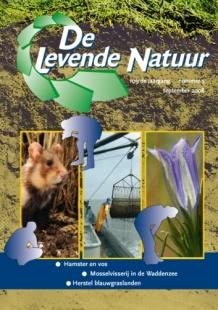De Levende Natuur nummer 5 van 2008 (English summary)
Afbeelding

Does the Common hamster (Cricetus cricetus) benefit from hunting Foxes?
Since 2002 the Common hamster (Cricetus cricetus) has been reintroduced in special areas with hamster-friendly management in the South of The Netherlands. Besides hamster-friendly management other protection measures like the control of Foxes (Vulpes vulpes) were undertaken to maximize reintroduction success. The control of Foxes, however, is controversial.
To assess if predator control i.e. fox hunting had any effect on hamster survival the death causes of 277 hamsters were determined. Predation by Foxes appeared to be the most important death cause of the hamsters, although birds of prey and martens also predated heavily on hamsters.
Hamster survival mainly depended on origin (captive-bred or wild-born), and gender. Differences among years and areas were only minor and had no significant effect on survival, although the main causes of death highly differed between areas. A direct positive effect of fox control on hamster survival could not be detected.
An estimation of survival rate was calculated hypothesizing that predation by Foxes dropped to zero and that all these non-predated hamsters would stay alive. Under this scenario the survival of wild female hamsters would increase with 2%, of wild males with 27%, of captive-bred females with 21%, whereas captive-bred males would profit most with an increase in survival of 39%.
Therefore it was concluded that predation control by hunting Foxes seems not necessary for the protection of wild hamster population, because it will probably have no significant effect on population growth and persistence. In reintroduction of captive-bred hamsters, however, each individual is important and fox control may increase the survival of some of these reintroduced hamsters and enhance the establishment of a new population.
Restoration of fen meadows in the Empese and Tondense Heide?
A.J.M. Jansen, A.M.J. Sloot, S. Soede & M. van Ham
The Empese en Tondense Heide is a small and endangered nature reserve in the eastern part of The Netherlands, characterized by wet heathlands, fen meadows, soft-water ponds and alder carrs. Since it was founded as a nature reserve many endangered species of the Red List have disappeared, mainly due to the impact of drainage of its surroundings and subsequent decrease of upward seepage of groundwater. As part of the preparation of restoration measures an eco-hydrological analysis was carried out. It became obvious that upward seepage of base-rich groundwater only has remained in a very small part of the reserve. Further, upward seepage of base-rich groundwater seems to be determined by local features i.e. the rise of groundwater tables in sandy ridges and the inundation of slacks during the wet part of the year, forcing base-rich groundwater to discharge at the border of the temporal pools. During summer the groundwater flow is directed by the regional topography and drainage base and no upward discharge appears. To restore the former area with upward discharge measures are required, which raise the summer groundwater table i.e. the infilling of deep brooks and ditches near the reserve. The first response of the vegetation and the winter groundwater tables seems promising.
Positive experiences with restoration of grasslands in the Krimpenerwaard
M.E.W. van der Welle, A. Beckers & T. van den Broek
In the Krimpenerwaard plans are made to restore 2450 ha of wetlands, including species rich, nutrient poor grasslands and grasslands suitable for breeding fen-meadow birds. In the project several restoration measures were investigated in a small part of the Krimpenerwaard to determine which measures were successful and could be used on a larger scale.
The measures aimed at restoring, wet, nutrient poor conditions and included grazing (at a low density), mowing, increasing the surface water level, and top soil removement, all without fertilization. The experiments started in 1994 and were monitored during 10 years.
Top soil removement proved to be the most successful measure: resulting in the highest plant species diversity with the highest number of target species from nutrient poor, wet grassland. Increasing the surface water level also had a positive effect on species richness. Mowing and grazing without increasing the surface water level had little or no effect on the species richness or plant species composition.
It is concluded that both topsoil removement and increased surface water level were suitable measures to be used on a larger scale. To restore and maintain species rich grasslands however, it is very important to prevent (superficial) acidification from stagnating rainwater and to avoid a strongly concave groundwater level.


